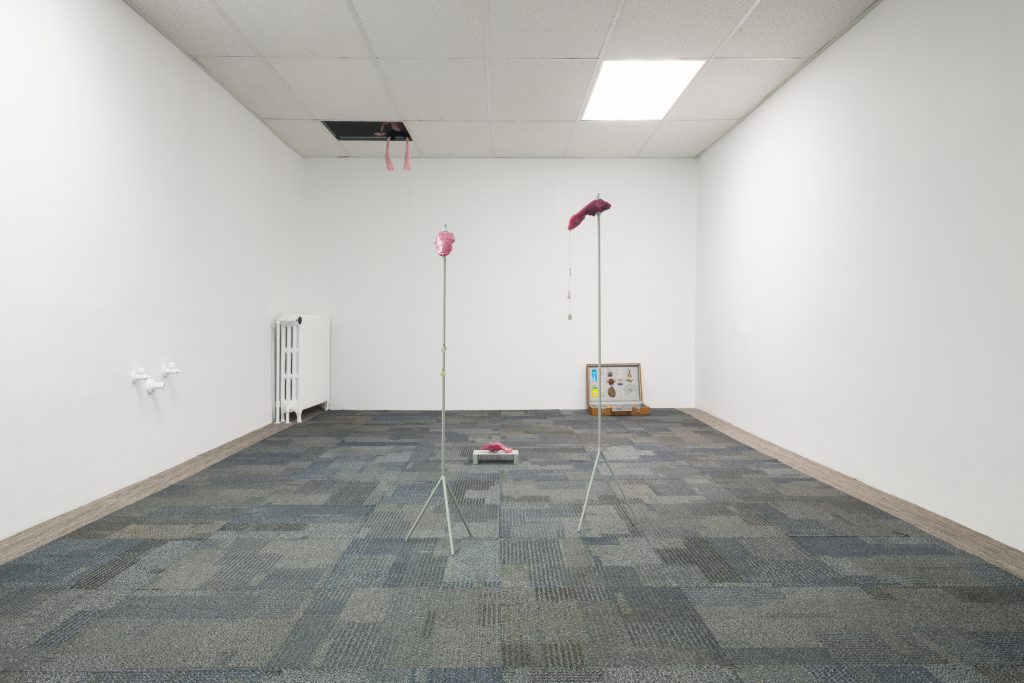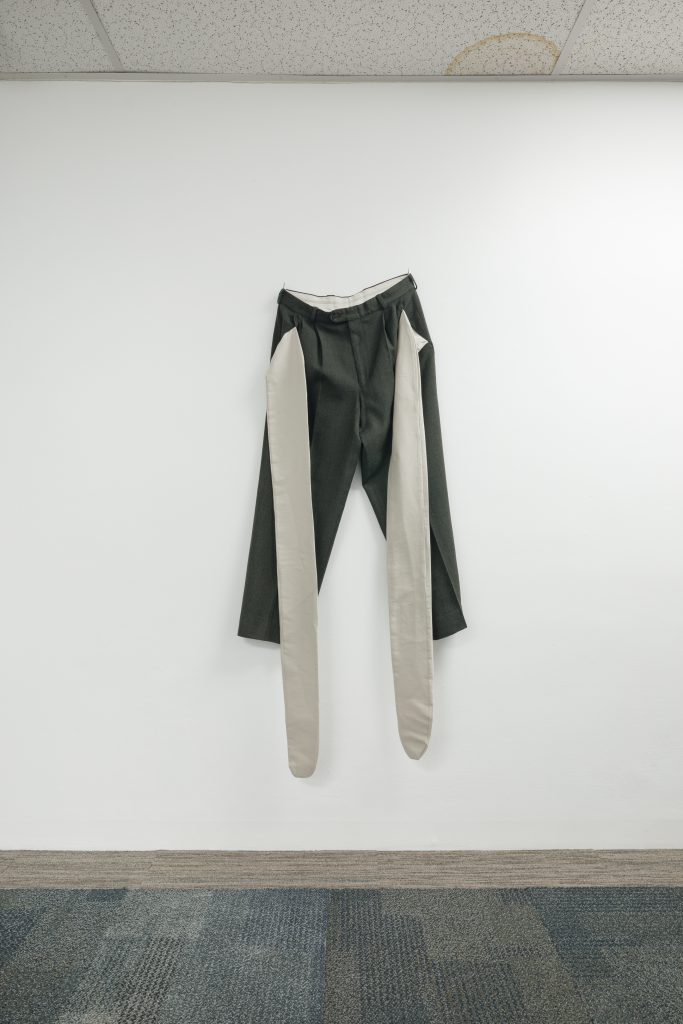when the big E unfurls its tongue: Michael Lachman at CSA Space
23 September 2021
By Alexandra Box
“Man’s greatness is always to recreate his life, to recreate what is given to him, to fashion that very thing which he undergoes. Through work he produces his own natural existence. Through science he recreates the universe by means of symbols. Through art he recreates the alliance between his body and his soul.”
– Simone Weil, The Mysticism of Work, Gravity and Grace (1947)
Late-capitalist mediascapes require the attention of the broader visual world that existed before workers encountered an economic and hygienic reordering due to mass death and unemployment, such as the affordance to some for working remotely. This social and biological decline is making it difficult—at most times, unsafe—to show up in traditional ways for provocation, or a mundane office job. Labour can only benefit from collective reflection, particularly on culture (abstraction, ornament, material, narrative) coming out of charged social and material conditions. Artist Michael Lachman grips onto the strength of fiction and satire as sculptural strategies in his solo exhibition, Let Me Introduce Myself, at CSA Space in Vancouver. Lachman transforms the gallery into a dreamlike office space riddled with stylized artifacts, producing a comedic story told by objects. Technical changes to the gallery space, such as dropping the ceiling height and lining the floor with blue modular carpet, reduced the standing posture for viewers and added to the satirical landscape of “the office.” The exhibition encapsulates the methodical rituals of the nine-to-five workday using comedy, as Lachman steers gallery visitors towards cultural mores, overdetermined ideas of professionalism, and the absurdities of manhood.
Two silicone casts of pig tongues stand side-by-side at attention, mutilated and ornamented with a fictitious currency that hangs from a chain affixed to each tongue, signifying the connection between commerce and mass production in animal agriculture. The coins that hang from the midline groove piercings in each tongue invite a narrative that is not bound to one particular economy or nation. It is as if the tongues are salivating from their own earnings. I cannot ignore the hilarious connection to trickle-down economics. With declining earnings in mind, the notion of “free time” exists only as fantasy for those who fall under the emergent categories of art labourers and culture workers, which attempt to encapsulate the many things that those working in the arts must be in order to compete and survive. An increasing lack of free time for the working classes points to the urgency of a new kind of resource redistribution. Likewise, Lachman includes himself in the scenario of the office-inhabiting working stiff through his clever use of classic tropes and imagery.

The viewers’ formation of a narrative about the exhibition must dissect these tropes, as well as more closely inspect how the office is supposed to provide workers with the “ideal” work setting. Strangely, the majority of wage labour goes against many of our natural cycles, namely by defying the biological clock. The proud yet perverse blurring of work-life boundaries in the arts comes from the idea that art is an extension of oneself, allowing for exploitative dispersals of time, likely from the normalization of overtime and contract work. In the deliberate remnants of decay present in the gallery’s features and furnishings, exhaustion signals the result of being robbed of free time, represented through the staged lack of upkeep, such as the waterlogged corners of ceiling tiles. There is an asymmetry in the unattended leaking and the immaculate installation of modular carpeting, taken to the degree of reverence for mass-produced synthetic furnishings.
The exhibition’s title, Let Me Introduce Myself, invokes networking events as representative cases of corporate ladder-climbing playgrounds—sites of man’s “inventive” drive. In many ways, the worker is the perfect storyteller to deliver a narrative that is endemic in all industries, reinventing himself in ways that distort his natural rhythms. Lachman’s use of the worker as storyteller draws inspiration from literature, particularly Herman Melville’s The Confidence-Man: His Masquerade (1857), a story about duplicity and deceit following an anonymous character sneaking onto a steamboat. The artist seems to share Melville’s affinity for a style that revels in indifference to diegetic particulars, and a prose whose sense of plotlessness is the upshot of a foggy narrator less committed to a distinctive curation of language. I see Melville’s plotless style as similar to the iterative process of Lachman’s sculptural work, wherein the artist’s works are more concerned with setting the stage—in this case, a corporate stage to enact exploitation.
Against walls across from each other are two wooden briefcases with bulky lead handles; one can imagine their owner has been taken by madness through their perpetual use, as a result of toxic lead accumulation. One briefcase is open, housing objects such as the pierced knot of a tree, elementary fishing tackle, petrified sea life in a square tin, and woven palm leaves, causing the viewer to wonder about the owner’s haptic encounters. The use of heavy metals also foregrounds the long capitalist history of resource extraction. An exploitative act against miners and stewards of the land, this theme of pilfery continues in the show’s textile work. Tongue-in-cheek alterations appear in a pair of work trousers hung like a painting on the wall, with pockets turned inside out and hanging comically long past the ankle cuff. The work evokes an imagined process of filling these extended pockets while shoplifting, or the metaphor of a wealthy individual with deep pockets, or the cartoonish image of someone turning their pockets inside out in search of lost money.

Across the gallery, as though surveilling the exhibition, is an omnipresent shirtless, pink puppet with pearls for eyes, perched in the ceiling and peering through the tiles. The hand sewn character wears glasses to emphasize his commanding gaze over the gallery. What authority does he have in this hazy office? Is he the boss? In this very crude rendering, the puppet’s childlike gaze sets up the rest of the works by pronouncing a boss’s perpetual supervision, a satirical optic of professionalization in the office space.
Humour and satire come up against a wall of stark professionalism (i.e. stoicism and diplomacy) in these traditional caricatures of the office space. Similarly, Let Me Introduce Myself involves us in an aesthetically sound set of questions about self-regulation, impulse, surveillance, and time theft. These questions pierce the exhibition’s abstract portrayal of the workforce, in turn asking the viewer to question the perverse fantasy of the nine-to-five, five-day workweek through narratives informed by careful looking. After all, under the current latter-day capitalist administration, we are paid in scratch-and-sniff fallacies, emblematic in Lachman’s fictional cast bronze coins. The visual world Lachman belongs to shows the alliance, often illusory, between the body and soul.
Let Me Introduce Myself by Michael Lachman ran from November 22, 2019 – January 9, 2020, at CSA Space in Vancouver, BC.
Feature Image: All works remain interchangeably titled as: The Subjects: Big Boss, The Colleagues, “Mr. E”, and Had it, Lost it, all 2019 by Michael Lachman. Photo by Dennis Ha courtesy of the artist.



